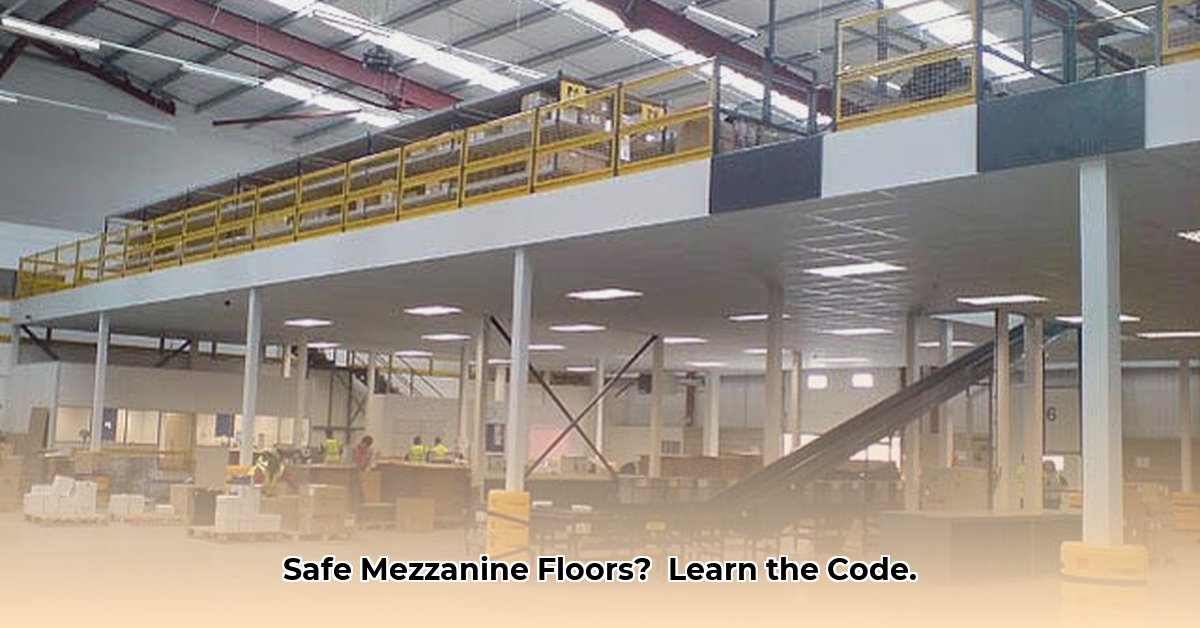Building a mezzanine offers valuable space, but safety is paramount. This instructional guide provides essential information on designing fire-rated mezzanine floors to ensure code compliance and protect your building and its occupants. We’ll explore material selection, design considerations, and common pitfalls to avoid. For more detailed design standards, see these mezzanine design standards.
Fire-Rated Mezzanine Floor Systems: A Practical Guide
This guide walks you through designing fire-rated mezzanine floors to meet codes and keep everyone safe.
Understanding the Building Codes: A Foundation for Mezzanine Structure Design
Before selecting materials, familiarize yourself with the International Building Code (IBC) and your local building regulations that serve as a guide for choosing materials and structural design for fire endurance. While there isn’t a specific “mezzanine fire rating” section, these codes outline material requirements and structural strength necessary to withstand a fire, focusing on maintaining structural integrity rather than complete fireproofing. This distinction ensures the building’s overall stability during a fire event. Consult with a qualified fire protection engineer or code official to ensure full compliance with all applicable regulations.
Choosing the Right Materials: A Key Aspect of Fire Resistant Mezzanine
Selecting appropriate materials can impact structural integrity and fire safety. For Type I and II buildings, non-combustible materials are typically required. Consider options like steel with fire-resistant coatings, concrete, or engineered wood products like ResinDek Xspan FR, which are specifically designed to meet stringent fire safety standards while providing robust floor support. When choosing materials, prioritize strength, fire resistance, and ease of installation to ensure a compliant and safe mezzanine structure, which helps avoid problems in the future. Always verify material certifications and testing data to ensure they meet the required fire ratings for your specific application.
Designing Your Fire-Safe Mezzanine: Fire Prevention Step-by-Step
This step-by-step plan makes sure you safely construct your mezzanine:
- Understand the Regulations: Thoroughly review the IBC and local codes, as requirements vary significantly. Consider factors like occupancy type, building height, and fire suppression systems when interpreting the codes.
- Conduct Structural Analysis: Ensure your design can support anticipated loads, even during a fire. Consult a structural engineer specializing in fire-resistant design for analysis. This is important for overall safety, compliance, and structural design. The analysis should consider the potential weakening of materials due to fire exposure.
- Select Fire-Rated Materials: Select materials that meet or exceed code requirements, verifying certifications from accredited testing laboratories such as UL or FM Approvals.
- Address Penetrations: Carefully address openings for pipes, wires, and HVAC systems, taking precautions based on your design and local fire codes, as these situations need to be carefully evaluated. Use approved firestop systems to seal penetrations and maintain the fire-resistance rating of the floor assembly.
- Develop Detailed Plans: Create comprehensive plans detailing materials, construction specifications, and fire protection measures. These plans should be reviewed and approved by a qualified fire protection engineer and the local building authority.
- Install Fire Suppression Systems: Integrate a fire suppression system, such as sprinklers, into the mezzanine design. Ensure the system is properly designed and installed to provide adequate coverage and protection for the mezzanine area.
- Provide Adequate Egress: Ensure the mezzanine has at least two remote means of egress that lead to a safe area outside the building. Egress routes should be clearly marked and illuminated, and they should meet all applicable code requirements for width, height, and travel distance.
- Perform Regular Inspections: After construction, regularly inspect the mezzanine to ensure continued safety and maintenance of fire safety features. This includes inspecting fire-rated materials, firestop systems, sprinkler systems, and egress routes. Keep detailed records of all inspections and maintenance activities.
Weighing Your Material Options: Comparing Mezzanine Decking Materials
Consider these material advantages and disadvantages:
| Material | Advantages | Disadvantages |
|---|---|---|
| Steel (with fireproofing) | Strong, long-lasting, and fire-resistant with the right coating. | Can be pricier and needs special fireproofing. |
| Concrete | Great fire resistance and super strong. | Heavy, which can put extra stress on the building’s structure. Requires specialized equipment and expertise for installation. |
| ResinDek Xspan FR | High fire rating, strong, and relatively easy to install. | Might cost more upfront than traditional wood. Limited size options may require more seams. |
| Traditional Wood Construction | Can be cheaper initially. | Very poor fire resistance; fire spreads quickly, leading to collapse. Generally not permitted in Type I and II construction. |
Addressing Common Questions and Concerns About Mezzanine Structure
Confusion often arises regarding the extent of firestopping needed for openings in fire-rated mezzanines. The primary focus is maintaining structural integrity during a fire. While complete sealing isn’t always necessary, applying extra fire-resistant sealant around openings is often prudent and may be mandated by local regulations. Seeking professional guidance is always recommended. Consult with a fire protection engineer to determine the appropriate firestopping requirements for your specific mezzanine design and building type.
Putting It All Together for Fire Rated Mezzanine
Constructing a code-compliant and safe mezzanine demands meticulous planning and attention to detail. By adhering to these guidelines and selecting appropriate materials, you can significantly minimize fire risks. Proactive planning and safety measures enhance workplace safety and protect your investment. When in doubt, seek professional assistance from qualified engineers, contractors, and code officials.
How to Ensure Mezzanine Fire Safety Code Compliance in Different Jurisdictions
Key Takeaways:
- Mezzanine installation requires strict adherence to OSHA, IBC, and local building codes.
- Non-compliance leads to serious financial and legal penalties.
- Thorough planning, professional installation, and comprehensive documentation are crucial.
- Understanding variations in local codes is essential for successful projects.
- Fire safety features, including materials, egress routes, and suppression systems, are paramount.
Understanding the Regulatory Landscape for Fire Safety Measures
Mezzanine floor design and installation involves ensuring the safety of building occupants through compliance with a complex web of regulations. It is essential to understand how to ensure mezzanine fire safety code compliance in differing jurisdictions. OSHA focuses on worker safety, the IBC (International Building Code) offers guidelines for structural and fire safety design. Because local jurisdictions often augment these requirements with specific amendments and interpretations, reviewing local building codes is essential. Furthermore, insurance providers may have their own fire safety requirements that must be met.
Step-by-Step Guide to Compliance in Mezzanine Structure
- Pre-Design: Conduct a comprehensive site assessment to identify potential hazards and local requirements. Engage a structural engineer experienced in mezzanine design and a fire protection engineer to ensure compliance from the outset. Consider factors such as the building’s construction type, occupancy classification, and proximity to other structures.
- Design: Create detailed design plans incorporating fire-rated materials that comply with IBC fire resistance ratings and any local amendments. Properly address egress routes, sprinkler system integration, fire alarm systems, and emergency lighting for life safety. The design should also consider the potential for smoke migration and the need for smoke control measures.
- Permitting: Obtain all required permits from local authorities by submitting detailed design plans and supporting documentation. Be prepared to address any questions or concerns raised by the building officials during the permit review process.
- Construction: Use qualified contractors experienced in fire-rated mezzanine installations, paying careful attention to detail and adhering to the approved design plans. Regular inspections by a qualified third-party inspector are essential to ensure compliance.
- Post-Construction: A final inspection by the local building authority will verify compliance. Maintain detailed documentation of the project, including materials used, inspection reports, and any modifications made during construction. Establish regular post-installation inspections and maintenance programs to ensure the continued effectiveness of the fire safety systems.
Specific Fire Safety Considerations in Mezzanine Structure
Fire safety not only considers the structural integrity of the mezzanine, but also specific parameters:
- Fire-rated materials: Ensure that all materials used in the construction of the mezzanine, including the flooring, beams, columns, and walls, meet the appropriate fire resistance ratings per the IBC and local codes. Obtain documentation from the manufacturer to verify the fire rating of each material.
- Egress routes: Provide accessible and clearly marked escape routes from the mezzanine level that meet all applicable requirements for width, height, travel distance, and number of exits. Ensure that the egress routes are free of obstructions and that emergency lighting is provided.
- Sprinkler systems: Integrate a sprinkler system designed for effective protection of the mezzanine and underlying structure, compatible with chosen materials and occupancy type. The sprinkler system should be designed and installed in accordance with NFPA 13.
- Fire alarm systems: Install a fire alarm system that provides early warning of a fire and alerts occupants to evacuate. The fire alarm system should be designed and installed in accordance with NFPA 72.
- Smoke control systems: Consider the need for smoke control systems to prevent the spread of smoke throughout the building in the event of a fire. Smoke control systems can include smoke vents, smoke barriers, and mechanical ventilation systems.
Navigating Jurisdictional Differences in Mezzanine Structure
Building regulations and their interpretations can vary significantly among jurisdictions which impacts the mezzanine structure. Early consultation with local authorities is essential, as assumptions about code uniformity can lead to delays and unexpected costs. Engage local experts to minimize potential issues and ensure compliance with all applicable codes and regulations. Be aware of any
- Glass Tile Shower Ideas to Create a Stunning Bathroom Space - December 7, 2025
- Glass Wall Tile Ideas for Kitchens and Bathrooms - December 6, 2025
- Glass Tile Bathroom: Create a Beautiful, Easy-Clean Space - December 5, 2025










